Challenges, and Future Perspective in Vehicular Ad-Hoc Networks
VerifiedAdded on 2019/09/20
|11
|3514
|300
Report
AI Summary
This report provides a comprehensive overview of Vehicular Ad-Hoc Networks (VANETs), focusing on the current challenges and future perspectives of V2V and V2I communication. It explores the system models, security, and privacy concerns within these networks, including the use of the WAVE standard and the ICAN protocol. The report discusses the importance of sensors, processing capabilities, and storage in V2V communication, along with the architecture of V2I systems and the role of OBUs and RSUs. It also highlights the security threats, including privacy issues related to PII, and the need for robust security measures to prevent unauthorized access and protect against external attacks. The report emphasizes the importance of early-stage security design to avoid costly redesigns and the need to address security challenges, particularly in the context of autonomous vehicles and the integration of V2I systems with the public internet. The report concludes by emphasizing the importance of securing vehicles against external attacks.

VEHICULA AD-HOC NETWORK
Vehicular Ad-Hoc Network: Current Challenges, and Future
Perspective
1
Vehicular Ad-Hoc Network: Current Challenges, and Future
Perspective
1
Paraphrase This Document
Need a fresh take? Get an instant paraphrase of this document with our AI Paraphraser
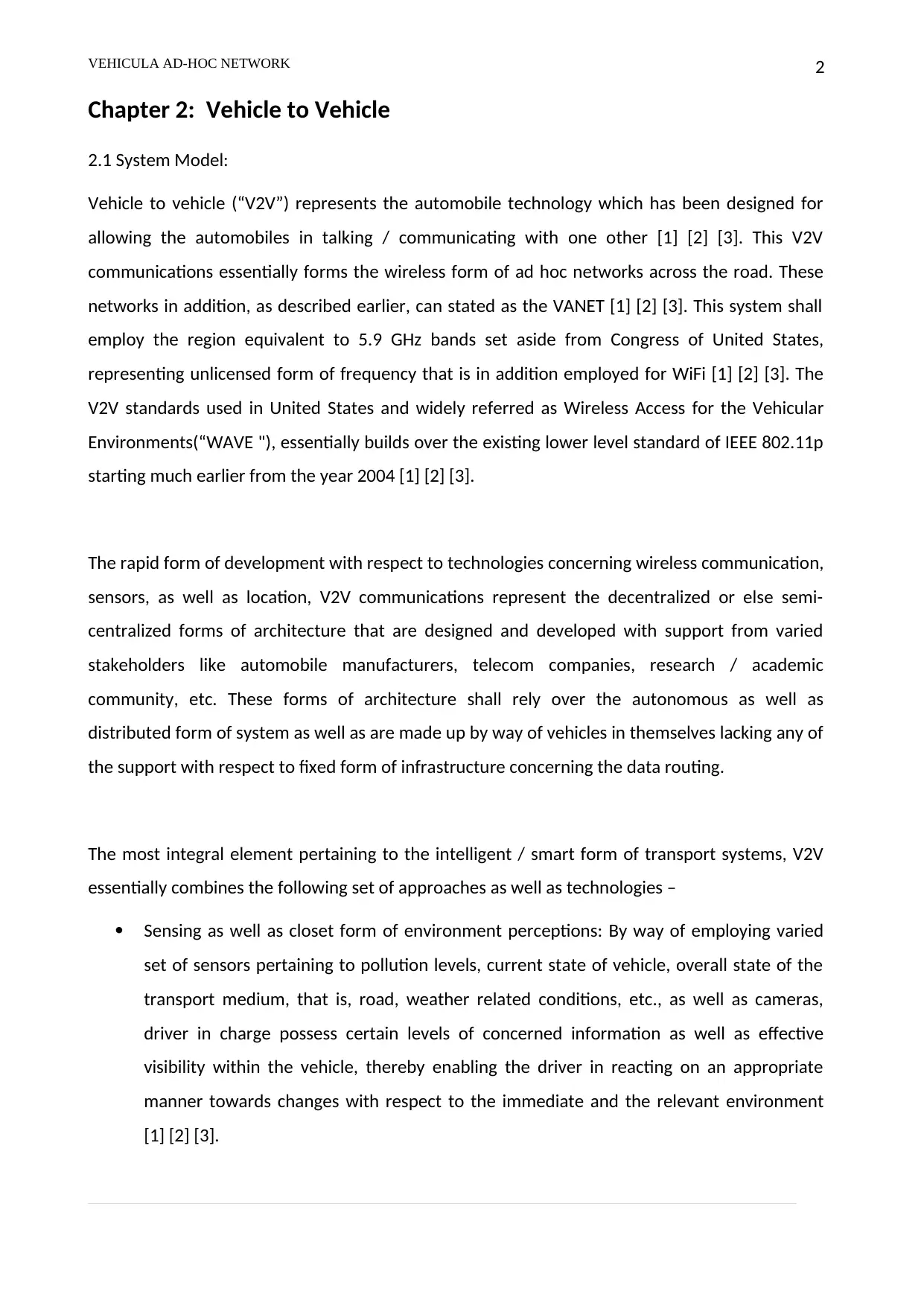
VEHICULA AD-HOC NETWORK
Chapter 2: Vehicle to Vehicle
2.1 System Model:
Vehicle to vehicle (“V2V”) represents the automobile technology which has been designed for
allowing the automobiles in talking / communicating with one other [1] [2] [3]. This V2V
communications essentially forms the wireless form of ad hoc networks across the road. These
networks in addition, as described earlier, can stated as the VANET [1] [2] [3]. This system shall
employ the region equivalent to 5.9 GHz bands set aside from Congress of United States,
representing unlicensed form of frequency that is in addition employed for WiFi [1] [2] [3]. The
V2V standards used in United States and widely referred as Wireless Access for the Vehicular
Environments(“WAVE "), essentially builds over the existing lower level standard of IEEE 802.11p
starting much earlier from the year 2004 [1] [2] [3].
The rapid form of development with respect to technologies concerning wireless communication,
sensors, as well as location, V2V communications represent the decentralized or else semi-
centralized forms of architecture that are designed and developed with support from varied
stakeholders like automobile manufacturers, telecom companies, research / academic
community, etc. These forms of architecture shall rely over the autonomous as well as
distributed form of system as well as are made up by way of vehicles in themselves lacking any of
the support with respect to fixed form of infrastructure concerning the data routing.
The most integral element pertaining to the intelligent / smart form of transport systems, V2V
essentially combines the following set of approaches as well as technologies –
Sensing as well as closet form of environment perceptions: By way of employing varied
set of sensors pertaining to pollution levels, current state of vehicle, overall state of the
transport medium, that is, road, weather related conditions, etc., as well as cameras,
driver in charge possess certain levels of concerned information as well as effective
visibility within the vehicle, thereby enabling the driver in reacting on an appropriate
manner towards changes with respect to the immediate and the relevant environment
[1] [2] [3].
2
Chapter 2: Vehicle to Vehicle
2.1 System Model:
Vehicle to vehicle (“V2V”) represents the automobile technology which has been designed for
allowing the automobiles in talking / communicating with one other [1] [2] [3]. This V2V
communications essentially forms the wireless form of ad hoc networks across the road. These
networks in addition, as described earlier, can stated as the VANET [1] [2] [3]. This system shall
employ the region equivalent to 5.9 GHz bands set aside from Congress of United States,
representing unlicensed form of frequency that is in addition employed for WiFi [1] [2] [3]. The
V2V standards used in United States and widely referred as Wireless Access for the Vehicular
Environments(“WAVE "), essentially builds over the existing lower level standard of IEEE 802.11p
starting much earlier from the year 2004 [1] [2] [3].
The rapid form of development with respect to technologies concerning wireless communication,
sensors, as well as location, V2V communications represent the decentralized or else semi-
centralized forms of architecture that are designed and developed with support from varied
stakeholders like automobile manufacturers, telecom companies, research / academic
community, etc. These forms of architecture shall rely over the autonomous as well as
distributed form of system as well as are made up by way of vehicles in themselves lacking any of
the support with respect to fixed form of infrastructure concerning the data routing.
The most integral element pertaining to the intelligent / smart form of transport systems, V2V
essentially combines the following set of approaches as well as technologies –
Sensing as well as closet form of environment perceptions: By way of employing varied
set of sensors pertaining to pollution levels, current state of vehicle, overall state of the
transport medium, that is, road, weather related conditions, etc., as well as cameras,
driver in charge possess certain levels of concerned information as well as effective
visibility within the vehicle, thereby enabling the driver in reacting on an appropriate
manner towards changes with respect to the immediate and the relevant environment
[1] [2] [3].
2
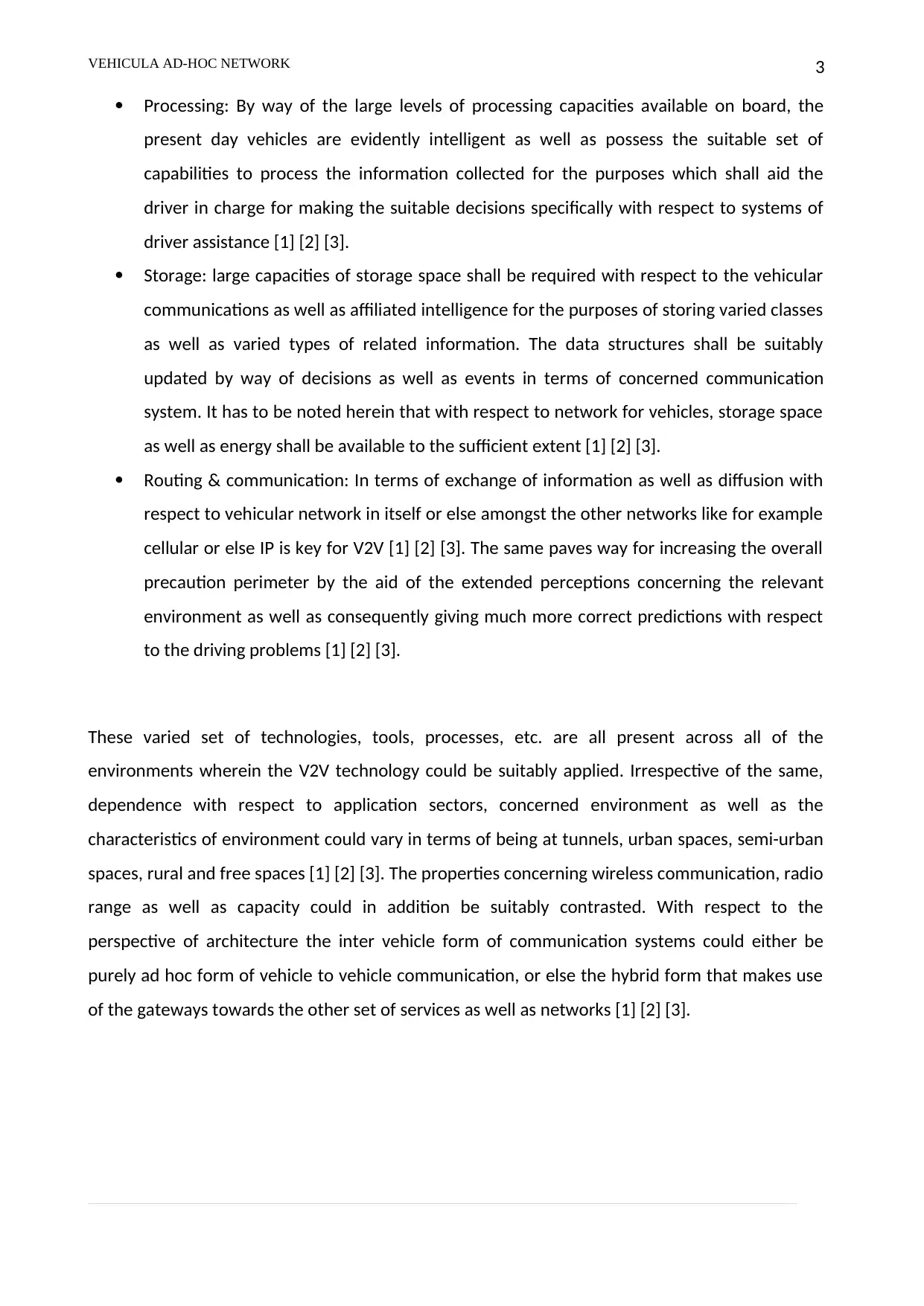
VEHICULA AD-HOC NETWORK
Processing: By way of the large levels of processing capacities available on board, the
present day vehicles are evidently intelligent as well as possess the suitable set of
capabilities to process the information collected for the purposes which shall aid the
driver in charge for making the suitable decisions specifically with respect to systems of
driver assistance [1] [2] [3].
Storage: large capacities of storage space shall be required with respect to the vehicular
communications as well as affiliated intelligence for the purposes of storing varied classes
as well as varied types of related information. The data structures shall be suitably
updated by way of decisions as well as events in terms of concerned communication
system. It has to be noted herein that with respect to network for vehicles, storage space
as well as energy shall be available to the sufficient extent [1] [2] [3].
Routing & communication: In terms of exchange of information as well as diffusion with
respect to vehicular network in itself or else amongst the other networks like for example
cellular or else IP is key for V2V [1] [2] [3]. The same paves way for increasing the overall
precaution perimeter by the aid of the extended perceptions concerning the relevant
environment as well as consequently giving much more correct predictions with respect
to the driving problems [1] [2] [3].
These varied set of technologies, tools, processes, etc. are all present across all of the
environments wherein the V2V technology could be suitably applied. Irrespective of the same,
dependence with respect to application sectors, concerned environment as well as the
characteristics of environment could vary in terms of being at tunnels, urban spaces, semi-urban
spaces, rural and free spaces [1] [2] [3]. The properties concerning wireless communication, radio
range as well as capacity could in addition be suitably contrasted. With respect to the
perspective of architecture the inter vehicle form of communication systems could either be
purely ad hoc form of vehicle to vehicle communication, or else the hybrid form that makes use
of the gateways towards the other set of services as well as networks [1] [2] [3].
3
Processing: By way of the large levels of processing capacities available on board, the
present day vehicles are evidently intelligent as well as possess the suitable set of
capabilities to process the information collected for the purposes which shall aid the
driver in charge for making the suitable decisions specifically with respect to systems of
driver assistance [1] [2] [3].
Storage: large capacities of storage space shall be required with respect to the vehicular
communications as well as affiliated intelligence for the purposes of storing varied classes
as well as varied types of related information. The data structures shall be suitably
updated by way of decisions as well as events in terms of concerned communication
system. It has to be noted herein that with respect to network for vehicles, storage space
as well as energy shall be available to the sufficient extent [1] [2] [3].
Routing & communication: In terms of exchange of information as well as diffusion with
respect to vehicular network in itself or else amongst the other networks like for example
cellular or else IP is key for V2V [1] [2] [3]. The same paves way for increasing the overall
precaution perimeter by the aid of the extended perceptions concerning the relevant
environment as well as consequently giving much more correct predictions with respect
to the driving problems [1] [2] [3].
These varied set of technologies, tools, processes, etc. are all present across all of the
environments wherein the V2V technology could be suitably applied. Irrespective of the same,
dependence with respect to application sectors, concerned environment as well as the
characteristics of environment could vary in terms of being at tunnels, urban spaces, semi-urban
spaces, rural and free spaces [1] [2] [3]. The properties concerning wireless communication, radio
range as well as capacity could in addition be suitably contrasted. With respect to the
perspective of architecture the inter vehicle form of communication systems could either be
purely ad hoc form of vehicle to vehicle communication, or else the hybrid form that makes use
of the gateways towards the other set of services as well as networks [1] [2] [3].
3
⊘ This is a preview!⊘
Do you want full access?
Subscribe today to unlock all pages.

Trusted by 1+ million students worldwide
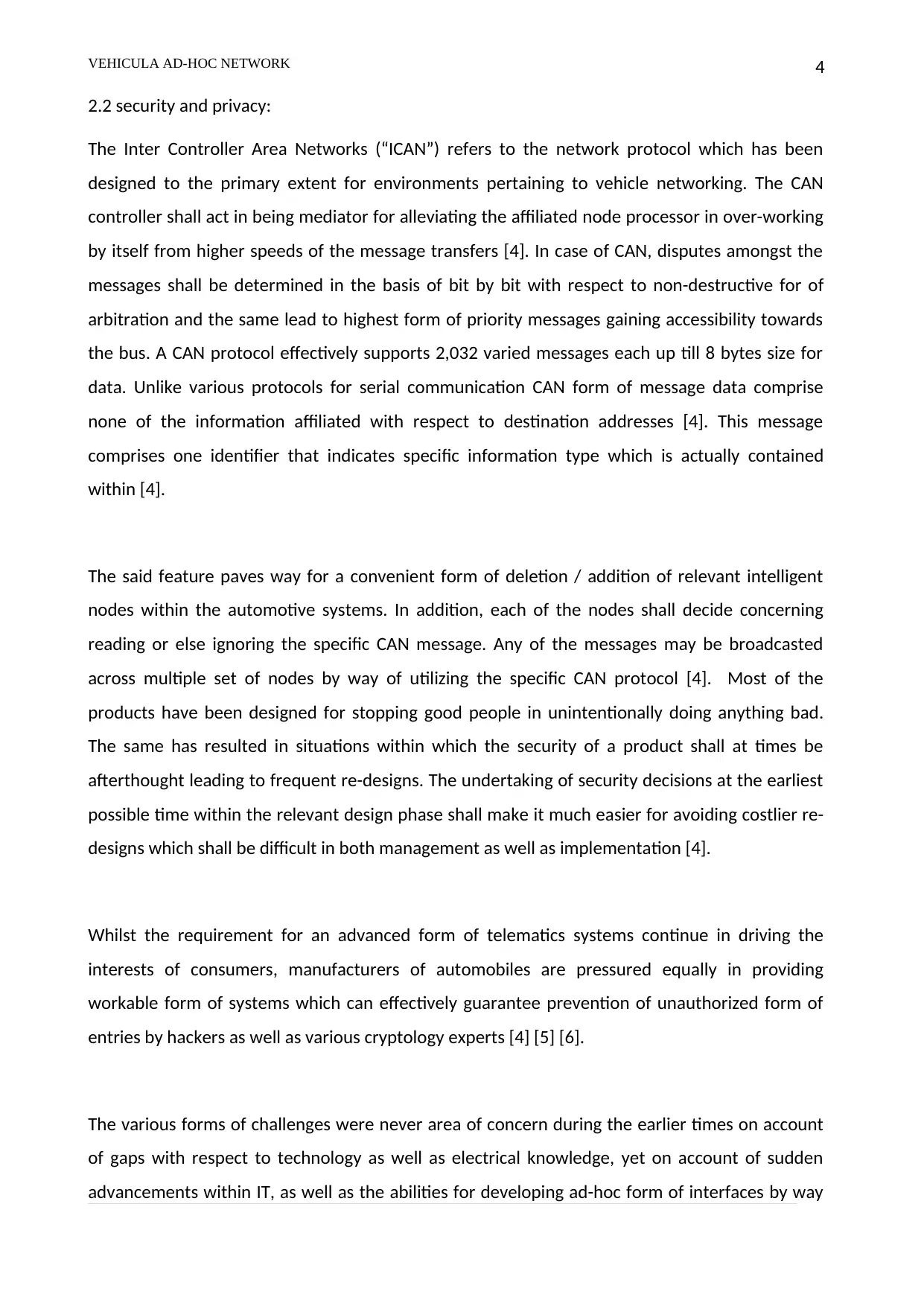
VEHICULA AD-HOC NETWORK
2.2 security and privacy:
The Inter Controller Area Networks (“ICAN”) refers to the network protocol which has been
designed to the primary extent for environments pertaining to vehicle networking. The CAN
controller shall act in being mediator for alleviating the affiliated node processor in over-working
by itself from higher speeds of the message transfers [4]. In case of CAN, disputes amongst the
messages shall be determined in the basis of bit by bit with respect to non-destructive for of
arbitration and the same lead to highest form of priority messages gaining accessibility towards
the bus. A CAN protocol effectively supports 2,032 varied messages each up till 8 bytes size for
data. Unlike various protocols for serial communication CAN form of message data comprise
none of the information affiliated with respect to destination addresses [4]. This message
comprises one identifier that indicates specific information type which is actually contained
within [4].
The said feature paves way for a convenient form of deletion / addition of relevant intelligent
nodes within the automotive systems. In addition, each of the nodes shall decide concerning
reading or else ignoring the specific CAN message. Any of the messages may be broadcasted
across multiple set of nodes by way of utilizing the specific CAN protocol [4]. Most of the
products have been designed for stopping good people in unintentionally doing anything bad.
The same has resulted in situations within which the security of a product shall at times be
afterthought leading to frequent re-designs. The undertaking of security decisions at the earliest
possible time within the relevant design phase shall make it much easier for avoiding costlier re-
designs which shall be difficult in both management as well as implementation [4].
Whilst the requirement for an advanced form of telematics systems continue in driving the
interests of consumers, manufacturers of automobiles are pressured equally in providing
workable form of systems which can effectively guarantee prevention of unauthorized form of
entries by hackers as well as various cryptology experts [4] [5] [6].
The various forms of challenges were never area of concern during the earlier times on account
of gaps with respect to technology as well as electrical knowledge, yet on account of sudden
advancements within IT, as well as the abilities for developing ad-hoc form of interfaces by way
4
2.2 security and privacy:
The Inter Controller Area Networks (“ICAN”) refers to the network protocol which has been
designed to the primary extent for environments pertaining to vehicle networking. The CAN
controller shall act in being mediator for alleviating the affiliated node processor in over-working
by itself from higher speeds of the message transfers [4]. In case of CAN, disputes amongst the
messages shall be determined in the basis of bit by bit with respect to non-destructive for of
arbitration and the same lead to highest form of priority messages gaining accessibility towards
the bus. A CAN protocol effectively supports 2,032 varied messages each up till 8 bytes size for
data. Unlike various protocols for serial communication CAN form of message data comprise
none of the information affiliated with respect to destination addresses [4]. This message
comprises one identifier that indicates specific information type which is actually contained
within [4].
The said feature paves way for a convenient form of deletion / addition of relevant intelligent
nodes within the automotive systems. In addition, each of the nodes shall decide concerning
reading or else ignoring the specific CAN message. Any of the messages may be broadcasted
across multiple set of nodes by way of utilizing the specific CAN protocol [4]. Most of the
products have been designed for stopping good people in unintentionally doing anything bad.
The same has resulted in situations within which the security of a product shall at times be
afterthought leading to frequent re-designs. The undertaking of security decisions at the earliest
possible time within the relevant design phase shall make it much easier for avoiding costlier re-
designs which shall be difficult in both management as well as implementation [4].
Whilst the requirement for an advanced form of telematics systems continue in driving the
interests of consumers, manufacturers of automobiles are pressured equally in providing
workable form of systems which can effectively guarantee prevention of unauthorized form of
entries by hackers as well as various cryptology experts [4] [5] [6].
The various forms of challenges were never area of concern during the earlier times on account
of gaps with respect to technology as well as electrical knowledge, yet on account of sudden
advancements within IT, as well as the abilities for developing ad-hoc form of interfaces by way
4
Paraphrase This Document
Need a fresh take? Get an instant paraphrase of this document with our AI Paraphraser

VEHICULA AD-HOC NETWORK
of hardware / software that are easily accessible, developers have been overwhelmed suddenly
with the concerns that are fueled on account of increased levels of knowledge / capabilities with
even an average hacker [4] [5] [6].
The various concerns / challenges are discussed as follows –
Privacy
The Personally Identifiable Information (“PII”) refers to any of the information akin to the name
of the person as well as phone number which could be utilized for distinguishing or else tracing
the identity of an individual [4] [5] [6]. Information which could be linked with the individual like
that of music, favorite shops, locations, etc. shall in addition be classified to be PII. In case of
devices that utilize PII, recommended form of security approach lies in initially considering all of
the information to be private as well as develop ability for being associated to the person or else
the individual level object as well as for later justifying why any of the data that is considered to
be not private [4] [5] [6]. Hence, PII should at all times be effectively secured, yet considered that
the secured do not essentially mean to be disclosed. The PII could be disclosed and yet solely by
way of the consent and the knowledge of the individual [4] [5] [6].
Other Security Issues
Any of the devices which shall connect with the external sources irrespective of it being
untrusted or else trusted form of sources shall have the inherent form of security threats which
shall b required in being suitably mitigated. Many of the threats of this form shall not be devices
which are specific and yet shall be effectively specific to communications [4] [5] [6]. Hence,
whenever one reviews the security aspects with respect to the systems of communications,
extreme form of care need be undertaken for not making any of the assumptions with respect to
anything [4] [5] [6]. Many of the systems as well as protocols with respect to communications
have been designed as well as developed prior to the securing of design related techniques that
existed. It has to be noted these set of practices have been developed on account of absence
concerning security within design as well as development. In addition, the adding of security
across the later date usually does not lead to the enhancement of security concerning the system
5
of hardware / software that are easily accessible, developers have been overwhelmed suddenly
with the concerns that are fueled on account of increased levels of knowledge / capabilities with
even an average hacker [4] [5] [6].
The various concerns / challenges are discussed as follows –
Privacy
The Personally Identifiable Information (“PII”) refers to any of the information akin to the name
of the person as well as phone number which could be utilized for distinguishing or else tracing
the identity of an individual [4] [5] [6]. Information which could be linked with the individual like
that of music, favorite shops, locations, etc. shall in addition be classified to be PII. In case of
devices that utilize PII, recommended form of security approach lies in initially considering all of
the information to be private as well as develop ability for being associated to the person or else
the individual level object as well as for later justifying why any of the data that is considered to
be not private [4] [5] [6]. Hence, PII should at all times be effectively secured, yet considered that
the secured do not essentially mean to be disclosed. The PII could be disclosed and yet solely by
way of the consent and the knowledge of the individual [4] [5] [6].
Other Security Issues
Any of the devices which shall connect with the external sources irrespective of it being
untrusted or else trusted form of sources shall have the inherent form of security threats which
shall b required in being suitably mitigated. Many of the threats of this form shall not be devices
which are specific and yet shall be effectively specific to communications [4] [5] [6]. Hence,
whenever one reviews the security aspects with respect to the systems of communications,
extreme form of care need be undertaken for not making any of the assumptions with respect to
anything [4] [5] [6]. Many of the systems as well as protocols with respect to communications
have been designed as well as developed prior to the securing of design related techniques that
existed. It has to be noted these set of practices have been developed on account of absence
concerning security within design as well as development. In addition, the adding of security
across the later date usually does not lead to the enhancement of security concerning the system
5
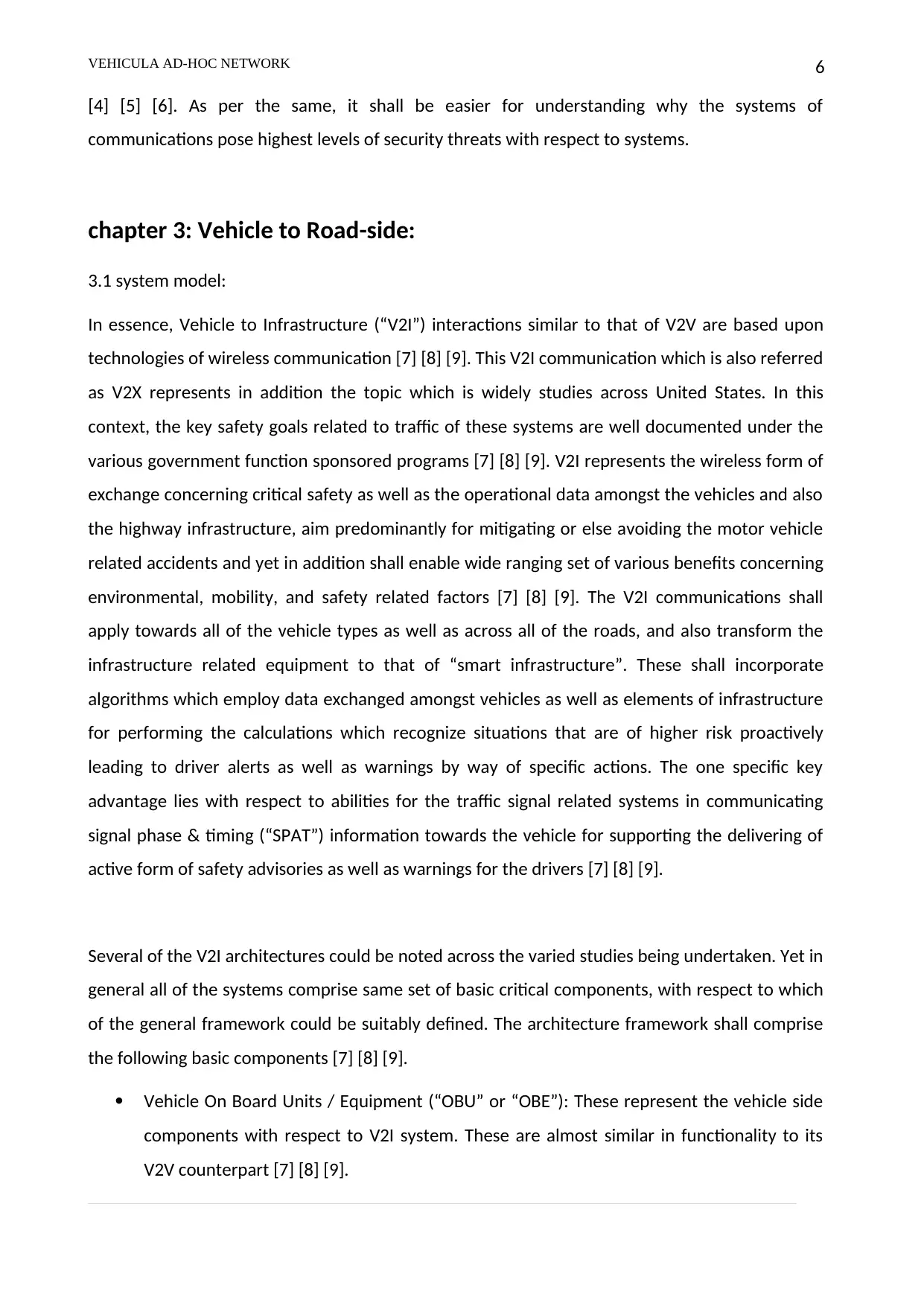
VEHICULA AD-HOC NETWORK
[4] [5] [6]. As per the same, it shall be easier for understanding why the systems of
communications pose highest levels of security threats with respect to systems.
chapter 3: Vehicle to Road-side:
3.1 system model:
In essence, Vehicle to Infrastructure (“V2I”) interactions similar to that of V2V are based upon
technologies of wireless communication [7] [8] [9]. This V2I communication which is also referred
as V2X represents in addition the topic which is widely studies across United States. In this
context, the key safety goals related to traffic of these systems are well documented under the
various government function sponsored programs [7] [8] [9]. V2I represents the wireless form of
exchange concerning critical safety as well as the operational data amongst the vehicles and also
the highway infrastructure, aim predominantly for mitigating or else avoiding the motor vehicle
related accidents and yet in addition shall enable wide ranging set of various benefits concerning
environmental, mobility, and safety related factors [7] [8] [9]. The V2I communications shall
apply towards all of the vehicle types as well as across all of the roads, and also transform the
infrastructure related equipment to that of “smart infrastructure”. These shall incorporate
algorithms which employ data exchanged amongst vehicles as well as elements of infrastructure
for performing the calculations which recognize situations that are of higher risk proactively
leading to driver alerts as well as warnings by way of specific actions. The one specific key
advantage lies with respect to abilities for the traffic signal related systems in communicating
signal phase & timing (“SPAT”) information towards the vehicle for supporting the delivering of
active form of safety advisories as well as warnings for the drivers [7] [8] [9].
Several of the V2I architectures could be noted across the varied studies being undertaken. Yet in
general all of the systems comprise same set of basic critical components, with respect to which
of the general framework could be suitably defined. The architecture framework shall comprise
the following basic components [7] [8] [9].
Vehicle On Board Units / Equipment (“OBU” or “OBE”): These represent the vehicle side
components with respect to V2I system. These are almost similar in functionality to its
V2V counterpart [7] [8] [9].
6
[4] [5] [6]. As per the same, it shall be easier for understanding why the systems of
communications pose highest levels of security threats with respect to systems.
chapter 3: Vehicle to Road-side:
3.1 system model:
In essence, Vehicle to Infrastructure (“V2I”) interactions similar to that of V2V are based upon
technologies of wireless communication [7] [8] [9]. This V2I communication which is also referred
as V2X represents in addition the topic which is widely studies across United States. In this
context, the key safety goals related to traffic of these systems are well documented under the
various government function sponsored programs [7] [8] [9]. V2I represents the wireless form of
exchange concerning critical safety as well as the operational data amongst the vehicles and also
the highway infrastructure, aim predominantly for mitigating or else avoiding the motor vehicle
related accidents and yet in addition shall enable wide ranging set of various benefits concerning
environmental, mobility, and safety related factors [7] [8] [9]. The V2I communications shall
apply towards all of the vehicle types as well as across all of the roads, and also transform the
infrastructure related equipment to that of “smart infrastructure”. These shall incorporate
algorithms which employ data exchanged amongst vehicles as well as elements of infrastructure
for performing the calculations which recognize situations that are of higher risk proactively
leading to driver alerts as well as warnings by way of specific actions. The one specific key
advantage lies with respect to abilities for the traffic signal related systems in communicating
signal phase & timing (“SPAT”) information towards the vehicle for supporting the delivering of
active form of safety advisories as well as warnings for the drivers [7] [8] [9].
Several of the V2I architectures could be noted across the varied studies being undertaken. Yet in
general all of the systems comprise same set of basic critical components, with respect to which
of the general framework could be suitably defined. The architecture framework shall comprise
the following basic components [7] [8] [9].
Vehicle On Board Units / Equipment (“OBU” or “OBE”): These represent the vehicle side
components with respect to V2I system. These are almost similar in functionality to its
V2V counterpart [7] [8] [9].
6
⊘ This is a preview!⊘
Do you want full access?
Subscribe today to unlock all pages.

Trusted by 1+ million students worldwide

VEHICULA AD-HOC NETWORK
Roadside Unit / Equipment (“RSU” or “RSE”): These shall be mounted across the
intersections, interchanges, as well as other locations like petrol stations offering an
interface for vehicles within the range [7] [8] [9].
Safer Communication Channel [7] [8] [9].
3.2 security and privacy:
Securing a vehicle against that of external attacks such that this vehicle shall not be remotely
hijacked represents highly realistic and possible threat [10] [11]. Naturally the shall be highly
important form of challenge in being addressed. The same shall be challenging especially with
respect to driver-less or else autonomous vehicles, on account of the design concerning the
vehicle necessitates to undertake navigation by itself by way of controlling its steering as well as
control systems in the vehicle [10] [11]. In essence, the brains pertaining to this vehicle or else as
it is known, OBU shall control movement pertaining to vehicle as well as this OBU shall be
connected with public internet as well as vehicular cloud. Hence, securing control systems
pertaining to vehicle shall be the primary thing which needs to be undertaken and the same is
solely possible by way of very strong / robust form of security systems being in place for securing
the vehicles against the cyber-attacks [10] [11].
The information which are collected by using the sensors of the car have to be suitably protected
as well as need to be solely used post making the same anonymous [10] [11]. The challenge
concerns the fact that one’s car need to warn one in case one is going beyond the speed limit
and yet should never turn against oneself, that is, by reporting to authorities that the driver went
beyond prescribed speed limits [10] [11]. Although, there shall be various instances wherein the
sharing of the location information amongst certain service providers may actually be
advantageous for an user like for example in case of insurance companies trying to offer
reduction with respect to insurance premiums in case such details shall be shared. There shall be
similar set of incentives by way of other set of service providers in using the sensor data of
vehicle as return for certain reward which could in actual encourage the participation from
concerned users [10] [11].
7
Roadside Unit / Equipment (“RSU” or “RSE”): These shall be mounted across the
intersections, interchanges, as well as other locations like petrol stations offering an
interface for vehicles within the range [7] [8] [9].
Safer Communication Channel [7] [8] [9].
3.2 security and privacy:
Securing a vehicle against that of external attacks such that this vehicle shall not be remotely
hijacked represents highly realistic and possible threat [10] [11]. Naturally the shall be highly
important form of challenge in being addressed. The same shall be challenging especially with
respect to driver-less or else autonomous vehicles, on account of the design concerning the
vehicle necessitates to undertake navigation by itself by way of controlling its steering as well as
control systems in the vehicle [10] [11]. In essence, the brains pertaining to this vehicle or else as
it is known, OBU shall control movement pertaining to vehicle as well as this OBU shall be
connected with public internet as well as vehicular cloud. Hence, securing control systems
pertaining to vehicle shall be the primary thing which needs to be undertaken and the same is
solely possible by way of very strong / robust form of security systems being in place for securing
the vehicles against the cyber-attacks [10] [11].
The information which are collected by using the sensors of the car have to be suitably protected
as well as need to be solely used post making the same anonymous [10] [11]. The challenge
concerns the fact that one’s car need to warn one in case one is going beyond the speed limit
and yet should never turn against oneself, that is, by reporting to authorities that the driver went
beyond prescribed speed limits [10] [11]. Although, there shall be various instances wherein the
sharing of the location information amongst certain service providers may actually be
advantageous for an user like for example in case of insurance companies trying to offer
reduction with respect to insurance premiums in case such details shall be shared. There shall be
similar set of incentives by way of other set of service providers in using the sensor data of
vehicle as return for certain reward which could in actual encourage the participation from
concerned users [10] [11].
7
Paraphrase This Document
Need a fresh take? Get an instant paraphrase of this document with our AI Paraphraser
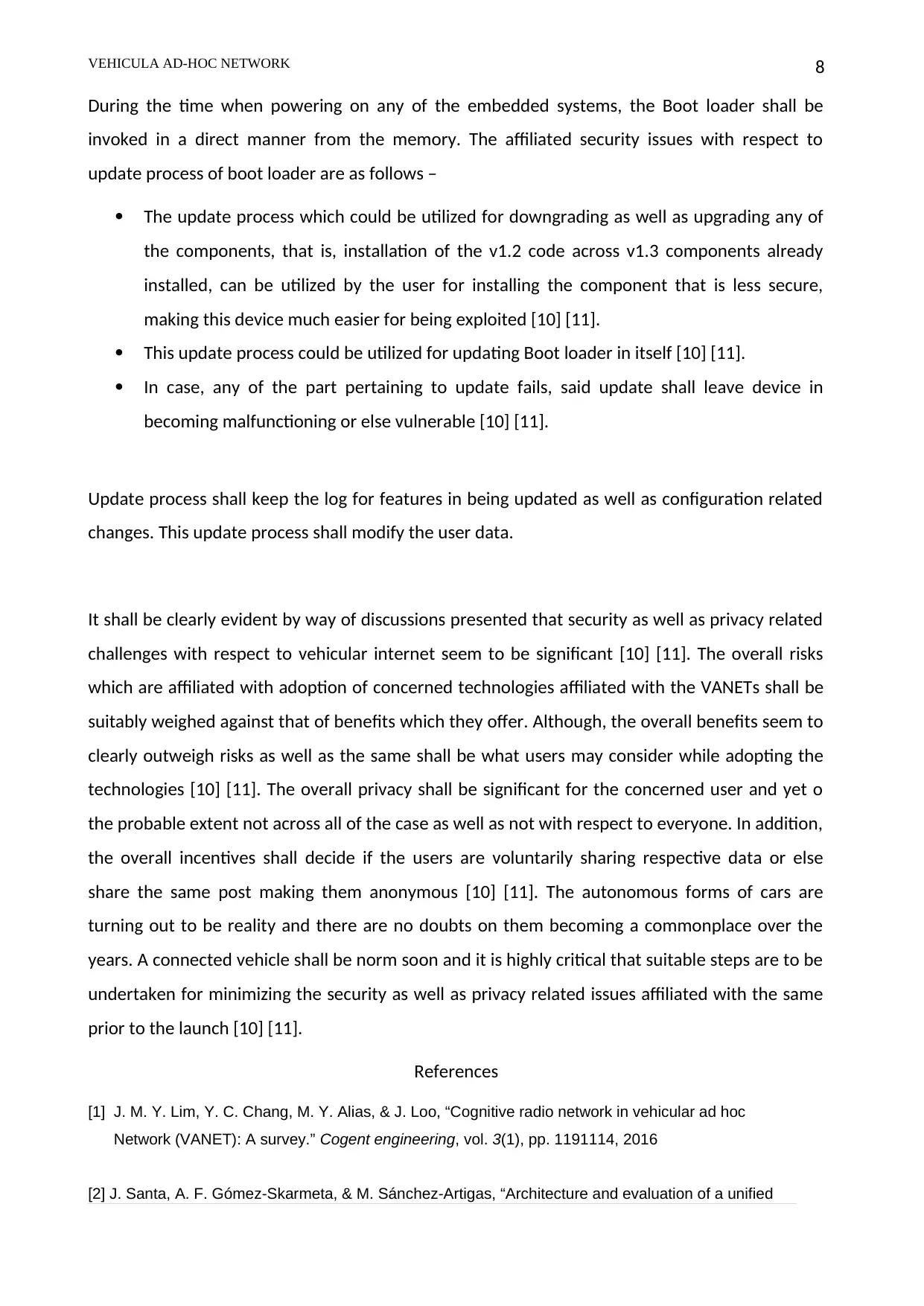
VEHICULA AD-HOC NETWORK
During the time when powering on any of the embedded systems, the Boot loader shall be
invoked in a direct manner from the memory. The affiliated security issues with respect to
update process of boot loader are as follows –
The update process which could be utilized for downgrading as well as upgrading any of
the components, that is, installation of the v1.2 code across v1.3 components already
installed, can be utilized by the user for installing the component that is less secure,
making this device much easier for being exploited [10] [11].
This update process could be utilized for updating Boot loader in itself [10] [11].
In case, any of the part pertaining to update fails, said update shall leave device in
becoming malfunctioning or else vulnerable [10] [11].
Update process shall keep the log for features in being updated as well as configuration related
changes. This update process shall modify the user data.
It shall be clearly evident by way of discussions presented that security as well as privacy related
challenges with respect to vehicular internet seem to be significant [10] [11]. The overall risks
which are affiliated with adoption of concerned technologies affiliated with the VANETs shall be
suitably weighed against that of benefits which they offer. Although, the overall benefits seem to
clearly outweigh risks as well as the same shall be what users may consider while adopting the
technologies [10] [11]. The overall privacy shall be significant for the concerned user and yet o
the probable extent not across all of the case as well as not with respect to everyone. In addition,
the overall incentives shall decide if the users are voluntarily sharing respective data or else
share the same post making them anonymous [10] [11]. The autonomous forms of cars are
turning out to be reality and there are no doubts on them becoming a commonplace over the
years. A connected vehicle shall be norm soon and it is highly critical that suitable steps are to be
undertaken for minimizing the security as well as privacy related issues affiliated with the same
prior to the launch [10] [11].
References
[1] J. M. Y. Lim, Y. C. Chang, M. Y. Alias, & J. Loo, “Cognitive radio network in vehicular ad hoc
Network (VANET): A survey.” Cogent engineering, vol. 3(1), pp. 1191114, 2016
[2] J. Santa, A. F. Gómez-Skarmeta, & M. Sánchez-Artigas, “Architecture and evaluation of a unified
8
During the time when powering on any of the embedded systems, the Boot loader shall be
invoked in a direct manner from the memory. The affiliated security issues with respect to
update process of boot loader are as follows –
The update process which could be utilized for downgrading as well as upgrading any of
the components, that is, installation of the v1.2 code across v1.3 components already
installed, can be utilized by the user for installing the component that is less secure,
making this device much easier for being exploited [10] [11].
This update process could be utilized for updating Boot loader in itself [10] [11].
In case, any of the part pertaining to update fails, said update shall leave device in
becoming malfunctioning or else vulnerable [10] [11].
Update process shall keep the log for features in being updated as well as configuration related
changes. This update process shall modify the user data.
It shall be clearly evident by way of discussions presented that security as well as privacy related
challenges with respect to vehicular internet seem to be significant [10] [11]. The overall risks
which are affiliated with adoption of concerned technologies affiliated with the VANETs shall be
suitably weighed against that of benefits which they offer. Although, the overall benefits seem to
clearly outweigh risks as well as the same shall be what users may consider while adopting the
technologies [10] [11]. The overall privacy shall be significant for the concerned user and yet o
the probable extent not across all of the case as well as not with respect to everyone. In addition,
the overall incentives shall decide if the users are voluntarily sharing respective data or else
share the same post making them anonymous [10] [11]. The autonomous forms of cars are
turning out to be reality and there are no doubts on them becoming a commonplace over the
years. A connected vehicle shall be norm soon and it is highly critical that suitable steps are to be
undertaken for minimizing the security as well as privacy related issues affiliated with the same
prior to the launch [10] [11].
References
[1] J. M. Y. Lim, Y. C. Chang, M. Y. Alias, & J. Loo, “Cognitive radio network in vehicular ad hoc
Network (VANET): A survey.” Cogent engineering, vol. 3(1), pp. 1191114, 2016
[2] J. Santa, A. F. Gómez-Skarmeta, & M. Sánchez-Artigas, “Architecture and evaluation of a unified
8
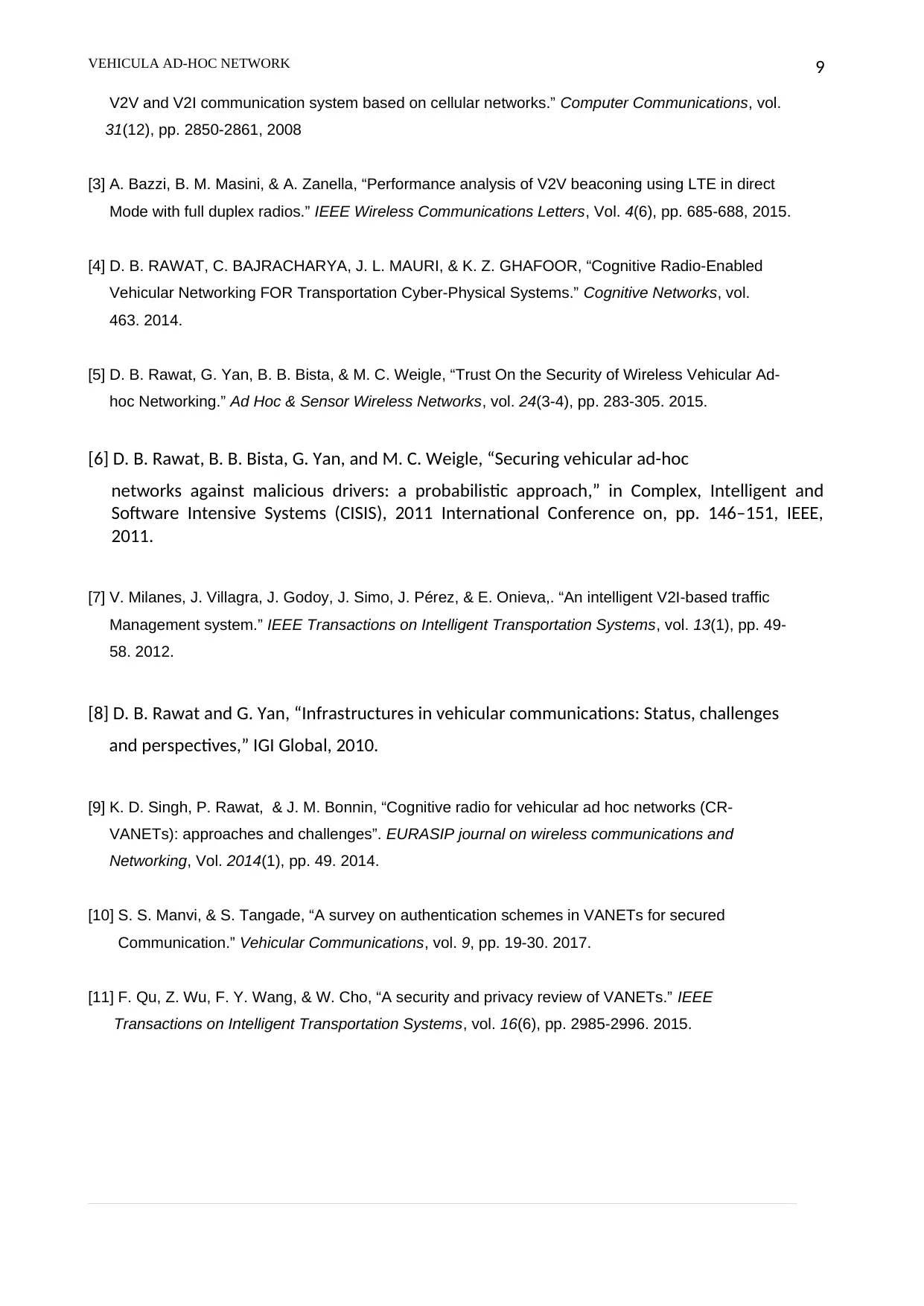
VEHICULA AD-HOC NETWORK
V2V and V2I communication system based on cellular networks.” Computer Communications, vol.
31(12), pp. 2850-2861, 2008
[3] A. Bazzi, B. M. Masini, & A. Zanella, “Performance analysis of V2V beaconing using LTE in direct
Mode with full duplex radios.” IEEE Wireless Communications Letters, Vol. 4(6), pp. 685-688, 2015.
[4] D. B. RAWAT, C. BAJRACHARYA, J. L. MAURI, & K. Z. GHAFOOR, “Cognitive Radio-Enabled
Vehicular Networking FOR Transportation Cyber-Physical Systems.” Cognitive Networks, vol.
463. 2014.
[5] D. B. Rawat, G. Yan, B. B. Bista, & M. C. Weigle, “Trust On the Security of Wireless Vehicular Ad-
hoc Networking.” Ad Hoc & Sensor Wireless Networks, vol. 24(3-4), pp. 283-305. 2015.
[6] D. B. Rawat, B. B. Bista, G. Yan, and M. C. Weigle, “Securing vehicular ad-hoc
networks against malicious drivers: a probabilistic approach,” in Complex, Intelligent and
Software Intensive Systems (CISIS), 2011 International Conference on, pp. 146–151, IEEE,
2011.
[7] V. Milanes, J. Villagra, J. Godoy, J. Simo, J. Pérez, & E. Onieva,. “An intelligent V2I-based traffic
Management system.” IEEE Transactions on Intelligent Transportation Systems, vol. 13(1), pp. 49-
58. 2012.
[8] D. B. Rawat and G. Yan, “Infrastructures in vehicular communications: Status, challenges
and perspectives,” IGI Global, 2010.
[9] K. D. Singh, P. Rawat, & J. M. Bonnin, “Cognitive radio for vehicular ad hoc networks (CR-
VANETs): approaches and challenges”. EURASIP journal on wireless communications and
Networking, Vol. 2014(1), pp. 49. 2014.
[10] S. S. Manvi, & S. Tangade, “A survey on authentication schemes in VANETs for secured
Communication.” Vehicular Communications, vol. 9, pp. 19-30. 2017.
[11] F. Qu, Z. Wu, F. Y. Wang, & W. Cho, “A security and privacy review of VANETs.” IEEE
Transactions on Intelligent Transportation Systems, vol. 16(6), pp. 2985-2996. 2015.
9
V2V and V2I communication system based on cellular networks.” Computer Communications, vol.
31(12), pp. 2850-2861, 2008
[3] A. Bazzi, B. M. Masini, & A. Zanella, “Performance analysis of V2V beaconing using LTE in direct
Mode with full duplex radios.” IEEE Wireless Communications Letters, Vol. 4(6), pp. 685-688, 2015.
[4] D. B. RAWAT, C. BAJRACHARYA, J. L. MAURI, & K. Z. GHAFOOR, “Cognitive Radio-Enabled
Vehicular Networking FOR Transportation Cyber-Physical Systems.” Cognitive Networks, vol.
463. 2014.
[5] D. B. Rawat, G. Yan, B. B. Bista, & M. C. Weigle, “Trust On the Security of Wireless Vehicular Ad-
hoc Networking.” Ad Hoc & Sensor Wireless Networks, vol. 24(3-4), pp. 283-305. 2015.
[6] D. B. Rawat, B. B. Bista, G. Yan, and M. C. Weigle, “Securing vehicular ad-hoc
networks against malicious drivers: a probabilistic approach,” in Complex, Intelligent and
Software Intensive Systems (CISIS), 2011 International Conference on, pp. 146–151, IEEE,
2011.
[7] V. Milanes, J. Villagra, J. Godoy, J. Simo, J. Pérez, & E. Onieva,. “An intelligent V2I-based traffic
Management system.” IEEE Transactions on Intelligent Transportation Systems, vol. 13(1), pp. 49-
58. 2012.
[8] D. B. Rawat and G. Yan, “Infrastructures in vehicular communications: Status, challenges
and perspectives,” IGI Global, 2010.
[9] K. D. Singh, P. Rawat, & J. M. Bonnin, “Cognitive radio for vehicular ad hoc networks (CR-
VANETs): approaches and challenges”. EURASIP journal on wireless communications and
Networking, Vol. 2014(1), pp. 49. 2014.
[10] S. S. Manvi, & S. Tangade, “A survey on authentication schemes in VANETs for secured
Communication.” Vehicular Communications, vol. 9, pp. 19-30. 2017.
[11] F. Qu, Z. Wu, F. Y. Wang, & W. Cho, “A security and privacy review of VANETs.” IEEE
Transactions on Intelligent Transportation Systems, vol. 16(6), pp. 2985-2996. 2015.
9
⊘ This is a preview!⊘
Do you want full access?
Subscribe today to unlock all pages.

Trusted by 1+ million students worldwide

VEHICULA AD-HOC NETWORK 10
Paraphrase This Document
Need a fresh take? Get an instant paraphrase of this document with our AI Paraphraser

VEHICULA AD-HOC NETWORK 11
1 out of 11
Related Documents
Your All-in-One AI-Powered Toolkit for Academic Success.
+13062052269
info@desklib.com
Available 24*7 on WhatsApp / Email
![[object Object]](/_next/static/media/star-bottom.7253800d.svg)
Unlock your academic potential
Copyright © 2020–2025 A2Z Services. All Rights Reserved. Developed and managed by ZUCOL.





